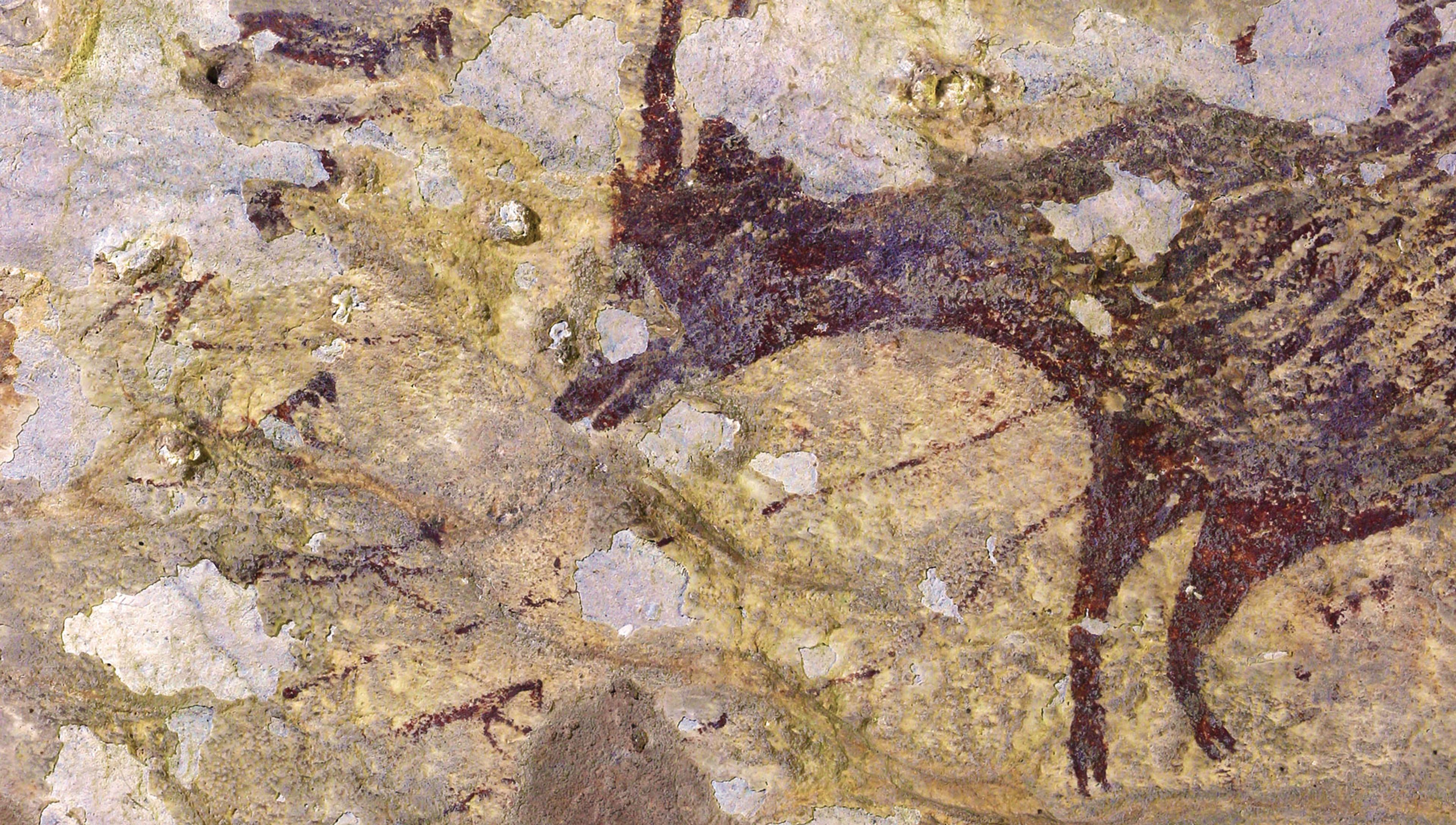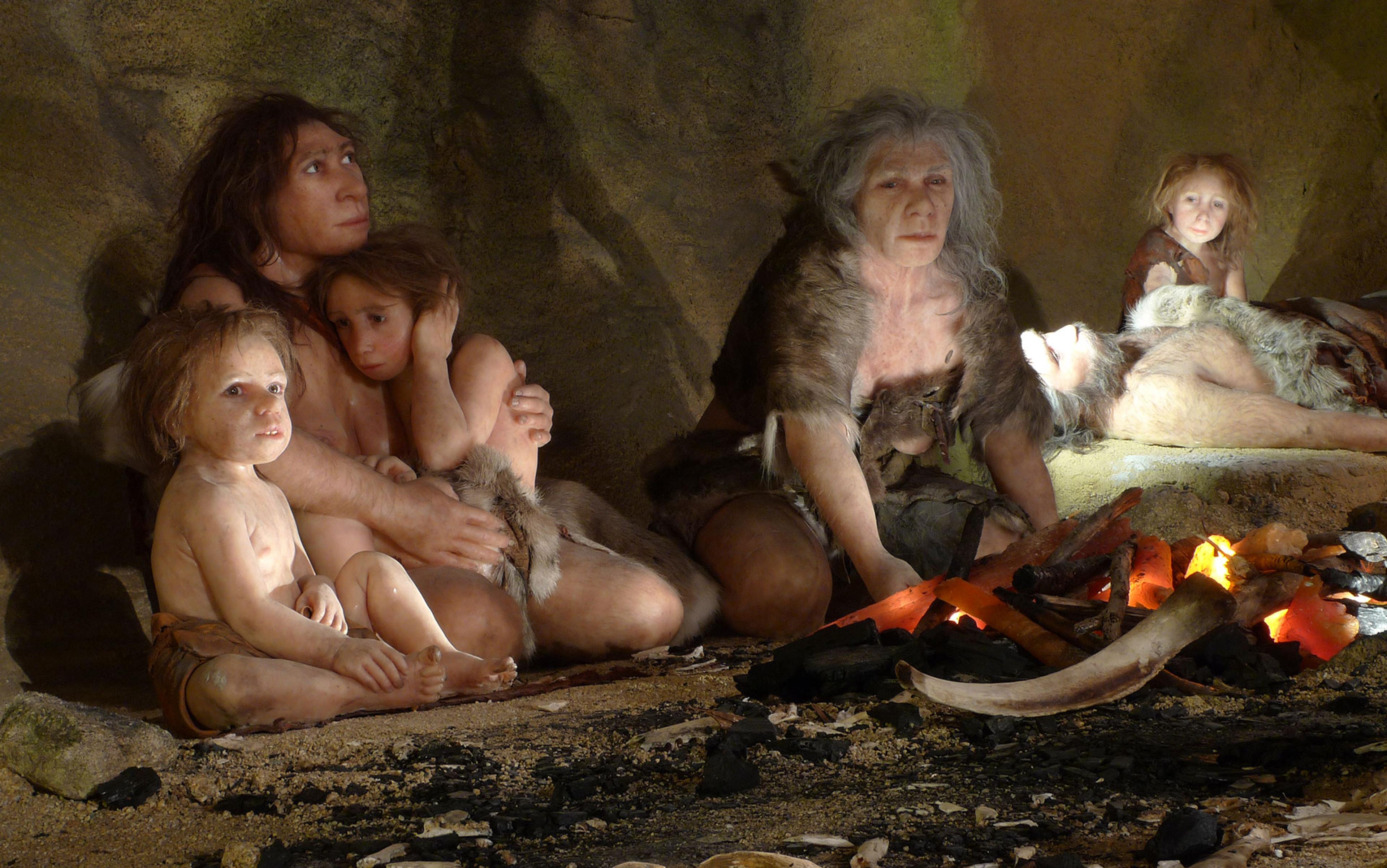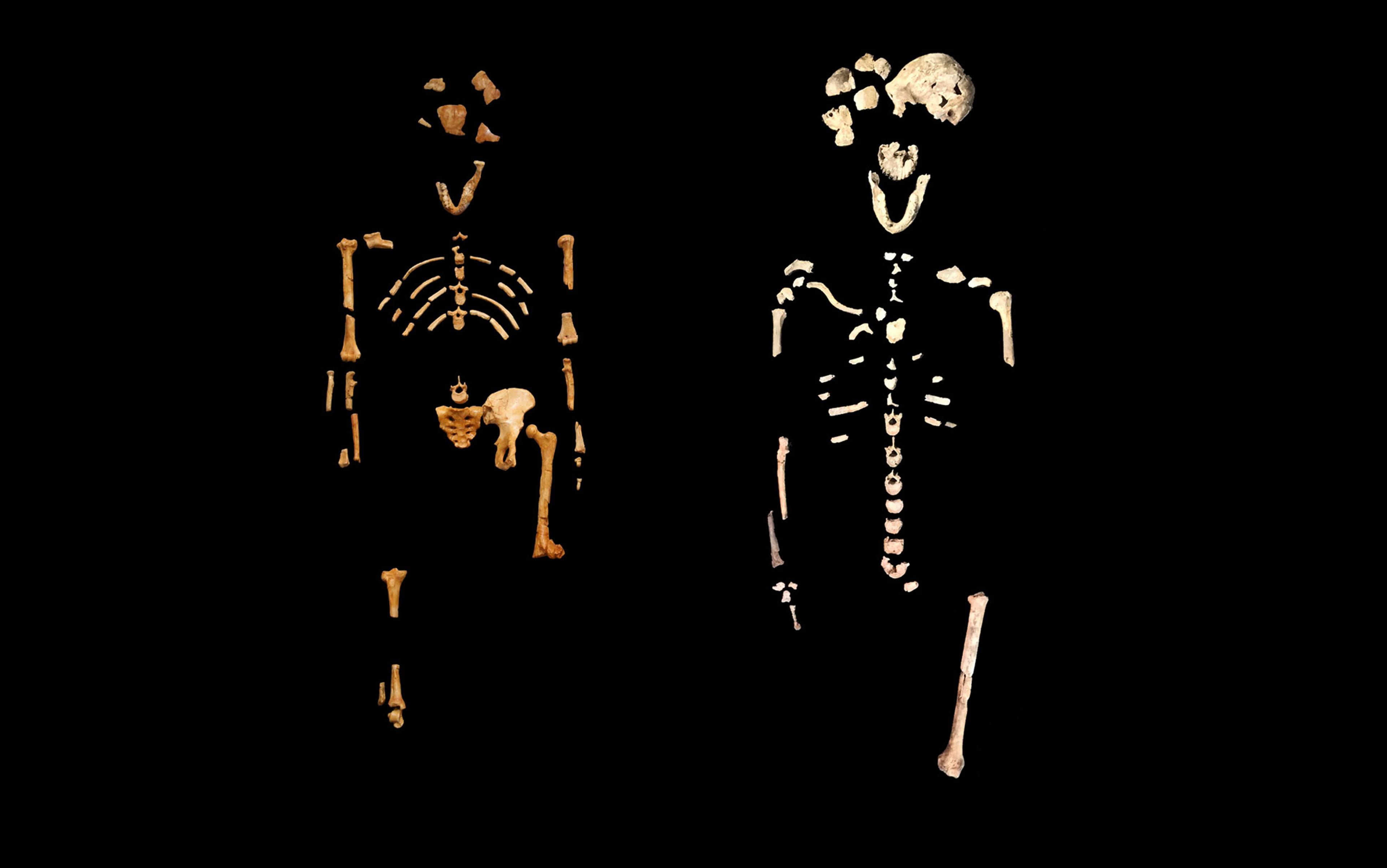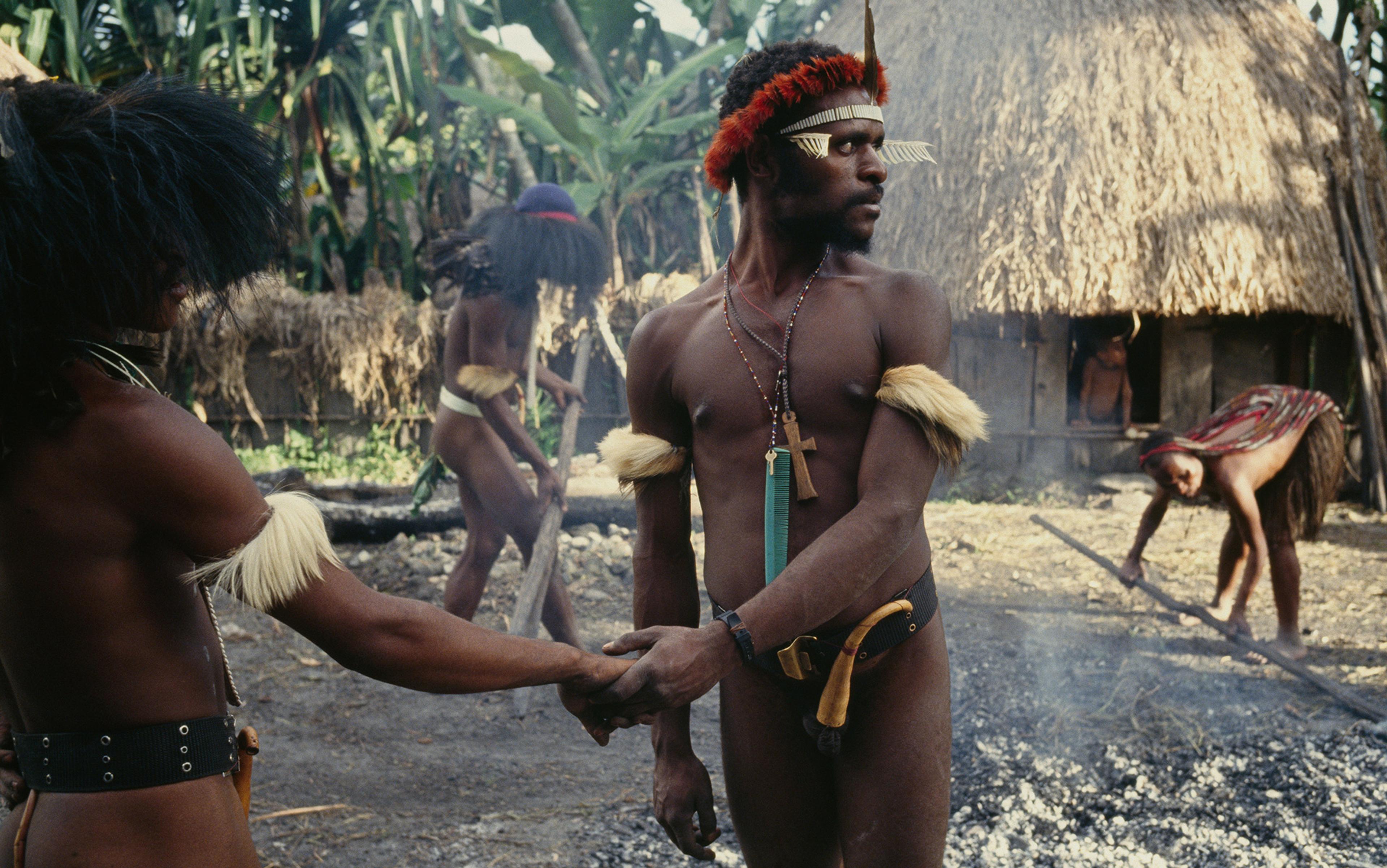When the anthropologist Irven DeVore suggested in 1962 to then-graduate student Richard Lee that they study hunter-gatherers, neither expected to transform the modern understanding of human nature. A baboon expert, DeVore mostly wanted to expand his research to human groups. Lee was searching for a dissertation project. Being interested in human evolution, they decided not to study peoples in the Americas or Australia, as was the norm in hunter-gatherer studies. Instead, they looked for a site that was, in Lee’s words, ‘close to the actual faunal and floral environment occupied by early man’. So, they headed to Africa – specifically, to the Kalahari.
Twice as big as California and, in places, three times as dry, the Kalahari is a red, scorched scar that yawns across Botswana and Namibia. It’s a brutal place. For nine months a year, the sun tortures the earth. There are no clouds and, with the exception of great scraggly baobabs, no tall trees that provide shade. When in 2013 the travel writer Andrew Evans visited Tau Pan, a settlement in the eastern Kalahari, he said it looked like ‘the deadest part of our planet’.
But appearances can be deceiving. Despite its harshness, the Kalahari still hosts a surprising clamour of life. There are cacti and acacia trees, hyenas and secretary birds, wildebeests and ostriches. There are antelopes that feed on roots and leopards that stalk them. And there are lions: hungry ones and scrawny ones and ones with black manes. According to local hunter-gatherers, some even float through the air. These, they said, were not true lions but shape-shifting sorcerers: former shamans who traded good medicine for evil poison.
The hunter-gatherers of the Kalahari are known collectively by many names – San, Bushmen, Baroa, Basarwa. The people whom DeVore and Lee studied – and who have since been visited by countless anthropologists – are known as the !Kung. (Like other Kalahari hunter-gatherers, the !Kung speak languages with clicks, represented with symbols such as ‘!’ and ‘ǂ’.)
The !Kung astounded DeVore and Lee. They had trance healing. They had an elaborate cosmology. They had a puzzling kinship system and deep ethnobotanical knowledge. ‘The Bushmen were so rich,’ DeVore later said in a video interview. ‘And we saw these poor people had not been well represented.’ Excited by their initial findings, the duo launched the Harvard Kalahari Project. An ambitiously multidisciplinary study aimed at documenting as much as possible about the !Kung, the project drew together ethnographers, demographers, archaeologists and psychologists.
‘We were able to sell it,’ DeVore said, ‘because we had this mantra almost, which is: for 100,000 years, or certainly more, we were hunter-gatherers. And we’ve only been something else in the last 10,000 years. And as late as time of Christ, 2,000 years ago, half the world was still hunter-gatherers. So, we’re really hunter-gatherers – never mind some of us wear Brooks Brothers suits – and we don’t know that life.’
The Harvard Kalahari Project propelled the !Kung into anthropological stardom. By 1976, researchers on the team had published more than 100 academic articles, on topics as varied as infant care, trance healing, and blood pressure. The research sparked more interest, which drew in more anthropologists, which produced more research. In a video for the Annual Review of Anthropology in 2012, DeVore speculated that there was no culture ‘outside the West that has as much fine-grained data on it’. In the same video, his Harvard colleague Peter Ellison said:
It’s not hard to appreciate why the !Kung San became such a paradigm within anthropology. They were hunter-gatherers for so many people and for so many generations. There was no other study that came close to that richness of detail.
Through research on the !Kung and similar hunter-gatherers, anthropologists now have a clear picture of what society looked like for most of our species’ history. We were mobile. We were egalitarian. We shared. We lived in small bands composed mostly of kin. We had few possessions and weak notions of property. Slavery was unknown. Then, 10,000 years ago: a rupture. The world warmed. Sea levels rose. We started to settle. We domesticated plants and animals. We invented inequality and slavery. Property intensified. War intensified. Societies became larger and more complex. Strangers became neighbours. We built courts. We built governments. We built monuments and bureaucracies and moralistic gods and every other instrument of power exercised in service of order and oppression. Prehistory ended. History began.
This is more than just a theory of prehistory. It’s the modern, scientific origin myth. Yes, we live in mega-societies with property and slavery and inequality but, at heart, we are mobile, egalitarian hunter-gatherers, wired for small groups and sharing. According to the evolutionary social scientist Peter Turchin, this view is ‘so standard that it is rarely formulated in explicit terms’. The archaeologist David Wengrow and the late anthropologist David Graeber described it as ‘the foundation of all contemporary debate on inequality’. This view serves as a narrative of human nature, a symbol of our capacity to establish good societies, and a reminder of just how far we have strayed in the past 10,000 years.
It’s also probably wrong.
In 1549, a vessel sailing from modern-day Colombia to Spain was shipwrecked on the south Florida coast. The survivors were taken captive by local peoples who, in turn, handed them over as tribute to the local king. One of the captives was Hernando de Escalante Fontaneda, the 13-year-old son of a conquistador. Not much is known about Fontaneda, but something about him must have appealed to his captors. Perhaps it was his youth. Perhaps he was linguistically gifted. Whatever the reason, the Indigenous peoples killed most of their captives, including Fontaneda’s older brother, yet decided to keep him alive. For 17 years, he lived, learned and travelled among the peoples of south Florida until a Spanish expedition rescued him in 1566.
No one today would know (or care) about Fontaneda were it not for his memoirs. These memoirs offer a rare glimpse into cultures whose histories were later erased by disease and colonialism. They describe people’s diets (‘in those freshwater rivers there are infinite eels, and very delicious’). They describe geography and place names (‘it is called the lake of Mayaimi because it is very large, and around it there are many small towns’). They even describe the mortuary practices of local nobility (‘they take the bones and attach one bone with another until they reassemble the man as he was, and they place him in a house that they have as a temple’). Most importantly for us, they describe the Calusa.
The Calusa ruled southern Florida. At the time of Spanish contact, they comprised 50 to 60 politically united villages along Florida’s southwest coast, although their domain extended far beyond that, from Tampa to Cape Canaveral and down to the Florida Keys: an area twice as large as modern-day Belgium. They collected tribute from client villages in the form of mats, hides, captives, feathers and breads made of roots. In return, they offered protection.
The Calusa built a state not through agriculture but through wild game
Both a kingdom and a state, the Calusa concentrated power in a hereditary sovereign who had life-and-death control over his subjects, a fact he demonstrated with regular human sacrifice. He ruled from the island of Mound Key – specifically, from a massive house perched atop a 32-foot-high mound and spacious enough to fit 2,000 people. He oversaw full-time military and priestly classes and funnelled surplus production into lavish celebrations. After one Calusa king met with the conquistador Pedro Menéndez de Avilés, an observer marvelled at the extravagance of the festivities, which included a choir of 500 adolescent Calusa girls who sang as long as Menéndez was in attendance. ‘This,’ the observer wrote, ‘was the greatest celebration, respect, and obedience that that chief, or any other in the land, could offer.’
The Calusa mobilised people for more than just singing. On Pine Island, they dug a 4 km-long canal, likely for fishing, exchange, transportation and tribute payments. Construction was a grand, collaborative project, involving the movement of 30,000 cubic metres of earth. They dug another canal through Mound Key, bisecting the island into mirrored halves. At the canal’s mouth, they built what archaeologists called ‘watercourts’ – inundated, rectangular structures, each thousands of square metres in area. A cross between enormous nets and living refrigerators, the watercourts ensured a reliable supply of live fish.
How did the Calusa build such a large, stratified society? A reasonable guess would be through agriculture. Perhaps they harvested maize, that mother of bounty and civilisation. Perhaps some lucky farmers ended up with more of it and converted that difference into power. Perhaps that power spiralled: inequities expanded, nobilities appeared and soon great farmer-kings collected maize by the boatload, storing it in granaries before paying military personnel to terrorise rural vassal-farmers into handing over more maize. Perhaps that maize supported priests and infrastructure and pubertal court singers.
Turns out, that’s not what happened. The Calusa built a state not through agriculture but through wild game – in particular, fish.
The Calusa are exceptional. They developed, as far as anthropologists know, the largest and most politically complex society of any non-agricultural people. But they’re not that exceptional. For more than a century, anthropologists have known of another set of foragers who developed sedentary and politically stratified societies: the peoples of the Pacific Northwest Coast. Inhabitants of temperate rainforests at the nexus of river and sea, these peoples harvested and stored salmon. They warred and took slaves. They lived in towns, some of which exceeded 1,000 people. Rather than suppressing inequality, they institutionalised it through potlatches – ceremonies in which hosts gained status through distributions of food, furs, slaves and houses.
If hunter-gatherers can build large, sedentary societies, why do we assume that they lived in small bands for most of our species’ history? Surely our ancestors preferred lush spots over the dead-looking Kalahari. And, once in those spots, surely they had the same political savvy to engineer semi-fixed, stratified societies. Yet many leading anthropologists still imagine the 100,000 years preceding agriculture to resemble, with slight variations, the lives of the mid-20th-century !Kung. Why?
One reason is that stratified foragers are unusual. Look at recent hunter-gatherers, and what do you see? You see dispersed clusters of Inuit families in the Arctic. You see Hadza bands sharing honey in eastern Tanzania. You see the Sirionó traipsing through the Amazon and Mbuti camps assembling for a nighttime dance in the Congo. You see, in short, small, mobile, egalitarian bands.
But looking at modern hunter-gatherers is misleading. For one, the more we dig through history, the more we encounter foragers who were sedentary and hierarchical. They covered Japan before agriculture. They dotted the South China coast before agriculture. They inhabited the Levant, tracts of the Nile, the beaches of southern Scandinavia, the central plains of Russia, the coasts of the Atacama Desert, and the grasslands of the high-altitude Andes – all before agricultural peoples dominated those regions. Even today, sedentary foragers live in riverine and coastal regions of New Guinea.
Sedentary and hierarchical hunter-gatherers are not unusual. If anything, it’s the profusion of mobile, egalitarian bands that might be the historical outlier. Rather than reflecting ancient ways, these small-scale societies are often products of modern forces. Rather than being untouched, many have been bullied, pacified, employed, enslaved and marginalised by colonial powers and agricultural neighbours.
!Kung society was less a pristine surrogate and more a product of interaction between foragers and farmers
Take the Sirionó of Bolivia, who were studied by the anthropologist Allan Holmberg in 1940-42. Living in small bands and lacking such basic innovations as traps and canoes, they seemed, in the words of the Cornell anthropologist Lauriston Sharp, ‘a still-living Old Stone Age people’ – ‘survivors who “from the beginning” retained a variety of man’s earliest culture.’ But the Sirionó of 1940 were not prehistoric relicts. They were refugees. Decades before Holmberg studied them, smallpox and influenza laid waste to their villages, levelling their population from 3,000 people to a mere 150. Centuries before that, the Sirionó might have splintered off from a larger, sedentary, agricultural tribe, the Chiriguanos, following predatory ambushes from a rival group. The cultural effects of the decimation were profound. In 2012, the anthropologist Robert Walker and his colleagues showed that, at some point in their history, the Sirionó suffered a devastating cultural collapse, losing canoes, shamanism, complex social structure and most of their agricultural lifestyle.
Did something similar happen to the !Kung? People often treat them as stand-ins for the beginning of societal evolution, as echoes of the Palaeolithic. But is that true? Did they really embody, as Lee once put it, ‘the basic human adaptation stripped of the accretions and complications brought about by agriculture, urbanisation, advanced technology, and national and class conflict’?
No. As Lee and the anthropologist Jacqueline Solway later admitted, !Kung society was less a pristine surrogate and more the product of a ‘long interaction between foragers, farmers, and herders’. The !Kung started trading with Bantu agriculturalists between 500 and 1,500 years ago. In the 1920s, Bantu farmers and herders entered !Kung lands so that, by the 1950s, the !Kung were incorporated into a larger pastoral economy. When the Harvard Kalahari Project was set up in 1963, 20 per cent of young !Kung men were working with cattle at any time. During his 1967-69 field trip, Lee recorded 51 per cent of !Kung men planting fields.
These interactions shaped !Kung society. According to Polly Wiessner, a leading anthropologist who has spent nearly four decades studying the !Kung, the egalitarianism for which the !Kung are so famous is a reflection not of a general hunter-gatherer lifestyle but of Bantu farmers displacing local leaders. ‘There’s indication that [the !Kung] had much stronger leadership,’ she said. ‘And they had some clan-like system that we can’t understand anymore and a more complex social organisation. We know that. We’ve all tried to reconstruct it, but we can’t. But before the Bantu came in, it would’ve been a somewhat different society.’
One day, 23,500 years ago near the coasts of modern-day Italy, an exceptionally tall 15-year-old boy was maimed by an animal – a bear, perhaps, or a hyena. The animal tore off a chunk of his lower jaw, yet miraculously the boy made it out alive. Maybe he slayed the beast. Maybe he fled. Maybe other people, eager to save the tall boy, burst in and drove the creature away. Whatever happened, the boy made it home. People probably cared for him. The wound began to heal. Ecstatic shamans may have even been summoned to accelerate the recovery. But, if they were, they failed. The damage was too great, the wound too incapacitating. A person can only get so far with half a mandible.
When the boy died, he was dressed in clothes stained with red ochre. He wore a pendant of mammoth ivory and a cap covered with hundreds of pierced shells and deer canines. He was buried with four ‘perforated batons’, enigmatic rods made of elk antler, like flattened, oversized spoons with crisp holes punched into the heads. In his right hand, he clutched a long blade crafted from high-quality flint mined from a basin 200 km away. At the site of his fatal wound was placed a cushion of yellow ochre: the leftover of a magical treatment, perhaps, or an attempt to conceal the injury. Astounded at how sumptuously this Palaeolithic hunter was treated, the Italian archaeologists who discovered the burial in 1942 nicknamed the boy ‘Il Principe’, or the Prince.
The Prince’s burial is one of a handful of lavish burials from the tens of thousands of years leading up to the agricultural revolution. There’s the ‘shaman from Brno’, a 23,500-year-old ochre-stained skeleton entombed with a cabinet of prehistoric curiosities: horse teeth, rhino ribs, tusk-shaped seashells, a mammoth-ivory marionette. There’s the ‘Lady of Saint-Germain-la-Rivière’, a crunched-up womanly skeleton that spent the past 16,000 years with blades, scrapers, seashells, antler daggers, a fox mandible, saiga antelope toes and some 70 red deer canines. And then there are the Sunghir burials. Roughly 30,000 years old and situated 200 km east of modern-day Moscow, these are the zenith of Upper Palaeolithic funerary extravagance. Especially striking are two adolescent boys: buried head-to-head, coated with ochre, accompanied by 16 mammoth-ivory spears and showered with more than 10,000 mammoth-ivory beads.
Some archaeologists see these as the graves of prehistoric aristocrats. They see rare, exotic and labour-intensive prizes buried with dead juveniles – juveniles who couldn’t have collected such trophies during their short lives and who must have instead received them from rich parents or relatives. They see inherited status, perhaps even social classes.
Others are more sceptical. When I spoke with Paul Pettitt, an archaeologist at Durham University in the UK, he warned me not to confuse a special death with a special position in life. ‘Just because a youngster has all this “rich” clothing doesn’t mean that they were important,’ he told me. The gravesites exhibit enough quirks – oddly traumatic deaths, puzzling physical deformities – that Pettitt wonders whether there was more going on than just highborns dying in style.
Archaeology is plagued by the impulse to underrate the sophistication of past peoples and to overrate our own
Still, for Pettitt, the burials overturn any assumption of simple, hyper-egalitarian bands. They indicate societies of specialists. They indicate status-minded, conspicuous consumption. Even if people were chucking deer canines and mammoth-tusk lances into the graves of people who died strange deaths, they still had the time and motivation to craft such fancy knick-knacks. ‘It’s inconceivable that Upper Palaeolithic hunter-gatherers were egalitarian,’ Pettitt said. ‘It just doesn’t work.’
The sumptuous burials provide strong indications of prehistoric social complexity – but only up to a point. Cognitively modern humans have been around for at least 200,000 years. We emerged, and spent most of our time, in Africa. Yet lavish Palaeolithic burials appear only around 30,000 years ago and then only in Europe. If our history has been socially diverse, if people lived not just in mobile bands but also in larger societies with hierarchy, sedentism and dense living, why is there such little evidence during the first 170,000 years of our history and in the continent in which we spent the bulk of our time? Where are the Princes of Palaeolithic Africa?
I asked this question to Christian Tryon, an archaeologist at the University of Connecticut who has worked in eastern Africa since 1997. The answer, he told me, ‘is probably that few people have looked.’ Africa remains an archaeological mystery. Compared with the throngs of fieldworkers digging through Europe, Tryon said, the number of people working in Africa is ‘trivial’.
Tryon’s point is important. Evidence of sedentism and stratification is like one of J R R Tolkien’s hobbits: easy to blunder past even when it’s staring you in the face. Just consider the Calusa. Their kingdom existed less than 500 years ago. They ruled an area larger than Switzerland. They were documented by Europeans. Their capital was 10 miles from the modern city of Cape Coral. Yet they were largely unknown to archaeologists until the 1970s. Now imagine a similar site in Africa, except that it lacks documentation, is older by 100,000 years, and is more remote from centres of archaeological research, plus far fewer people are digging around for it. The archaeological record is critical for reconstructing human history – there’s no question – but, as Tryon said, ‘I’m always hesitant to put too much meaning into the absence of something.’
Even with its gaps, however, the African archaeological record continues to defy our accounts of deep history. For most of the 20th century, researchers assumed that humans underwent a behavioural revolution around 40,000 years ago. Like a golem come to life, we were said to transform from a species that looked like us but lacked our mental charm into a form distinctly and cognitively human. It was then, the story went, that symbolism started, along with fishing, trading, shellfish extraction, pigment processing and anything else moderately impressive. We now know that story is wrong. We know that, by 125,000 years ago, and likely much earlier, people were living on South African coasts, eating mussels, sea snails, even seals and whales. They were crafting intricate tools, securing heat-treated quartzite bladelets to shafts of wood. They were engaging in long-distance exchange and embarking on expeditions to collect decorative red ochre. The history of archaeology has been plagued by what we might call ‘the hubris of modernity’: the impulse to underrate the sophistication of past peoples and to overrate our own.
Why does it matter what the Pleistocene looked like? Because prehistoric societies shaped human nature. Our minds evolved under ancient social conditions. If, until the past 10,000 years, we lived in small egalitarian bands, then those are the environments to which we’re psychologically adapted. Inequality, cooperation with strangers, complex political institutions – all are then alien to our evolved nature.
If, however, we evolved in both mobile bands and large hierarchical communities, then, by nature, we are much more psychologically flexible. We’re egalitarian, yes, but also predatory and hierarchical. We’re prepared to interact with familiar people, yes, but also ready to cooperate with strangers. The idea that human nature was forged in a chaos of sundry social environments might be more distressing than a narrative about small, egalitarian bands. But it explains the breadth of human behaviour and the ease with which we live in modern societies. The world today is unlike anything humans have experienced, yet in terms of their hierarchy, sedentism and political complexity, the societies we’ve built might still be deeply familiar.






